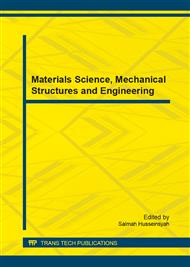p.119
p.123
p.127
p.131
p.135
p.140
p.146
p.150
p.154
Properties of Special Mortar Made with Raw Waste Material
Abstract:
The paper deals with the properties of a special mortar using a Waste Paper Sludge Ash (WPSA) from Waste Paper Recycling Industry and Bottom Ash (BA) from Coal Electric Power Stations. Special mortar with some advantages is proposed to give a significant impact for replacing of normal cement mortar. The advantages are approached due to the problem that occurred from collecting raw material such as pollution problems and environmental impact issues. Besides, the raw material sources of cement and sand is limited and this issue engages with the ideas to produce new material in mortar and masonry engineering. A total 72 cubes mortar is cast and determined their properties of chemical and mechanical. The properties of special mortar are compared with other special mortar made of other waste material. The compression strength of special mortar is conducted at the age 3, 7, 28 and 40 days of curing. From the result of chemical properties, it showed that the special mortar created the high compression strength value for all mixes. The compression strength of special mortar is increased by increasing the percentage sand replacement by BA. But, the compression strength is decreased when WPSA is increased. Finally, the special mortar with 100 % BA and 10 % WPSA showed the appropriate proportion for producing special mortar.
Info:
Periodical:
Pages:
135-139
Citation:
Online since:
October 2014
Price:
Сopyright:
© 2014 Trans Tech Publications Ltd. All Rights Reserved
Share:
Citation:


